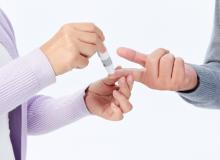If you don't pay attention to some details, it will lead to inaccurate blood glucose measurement. Let's take a look at what issues need to be paid attention to during the blood collection process?
1. The blood collection method must be appropriate
We all know that if a needle is inserted with ten fingers connected to the heart, the pain will not be small, so some people will cause the needle to be too shallow, less than 2 mm, and the needle does not completely penetrate the epidermis, resulting in insufficient bleeding, and excessive squeezing can cause The dilution of blood specimens by tissue fluid will cause falsely low results.
Does that mean you have to insert it hard? Of course it doesn’t. If the needle is inserted too deep, it will not only hurt, but it will also cause tension, which will excite the sympathetic nerves and increase blood sugar, resulting in inaccurate results.
Therefore, the puncture depth should be appropriate when collecting blood. The depth of the needle can be adjusted in time according to the thickness of the skin. The general penetration depth is 2 to 3 mm.
It is best to let the blood flow out naturally, or push forward from the base of the finger, not just squeeze the needle site.
2. Choose the appropriate scale
Generally, blood collection pens have several numbers "1~5", which are the depth of the needle penetrating the skin. You should adjust the depth of the blood collection needle according to the thickness of your skin.
If you are using it for the first time and have no idea about the depth, try adjusting the medium scale to "3" first, and then fine-tune it according to the usage.
The amount of blood collected is not necessarily more, as long as it meets the test requirements, and there is no need to waste blood.
3. Do not collect blood repeatedly from one site
Because the ring finger has richer blood, it is easier to collect blood. Compared with the other four fingers, the ring finger has less activity and is less susceptible to infection.
In addition to the ring finger, the middle finger and little finger are also affected. People who take more tests can spread the damage to every part as much as possible instead of repeating it many times in one or a few parts.
Be careful not to collect blood from your fingertips, but from both sides of your fingers. Because the nerve endings on both sides of your fingers are less distributed, the pain after acupuncture will be lighter.
You can remember the last blood collection site and avoid this site the next time you collect blood.
4. Skin cleansing
When measuring blood sugar, you must keep your fingers clean. Food residue or other dirt on your fingers will affect blood sugar values.
When measuring blood sugar, wash your hands with warm water and wait until the skin is dry before measuring.
The skin of people with diabetes becomes dry due to high blood sugar. If alcohol is used for disinfection, the skin will easily become drier, thicker, rougher and even cracked.
In order to prevent or reduce these adverse reactions, wash your hands with warm water and neutral soap or hand sanitizer before collecting blood. Warm water can increase blood circulation in your fingers. Try to avoid taking blood when your hands are cold. You can usually use some hand cream to help prevent dry skin!

